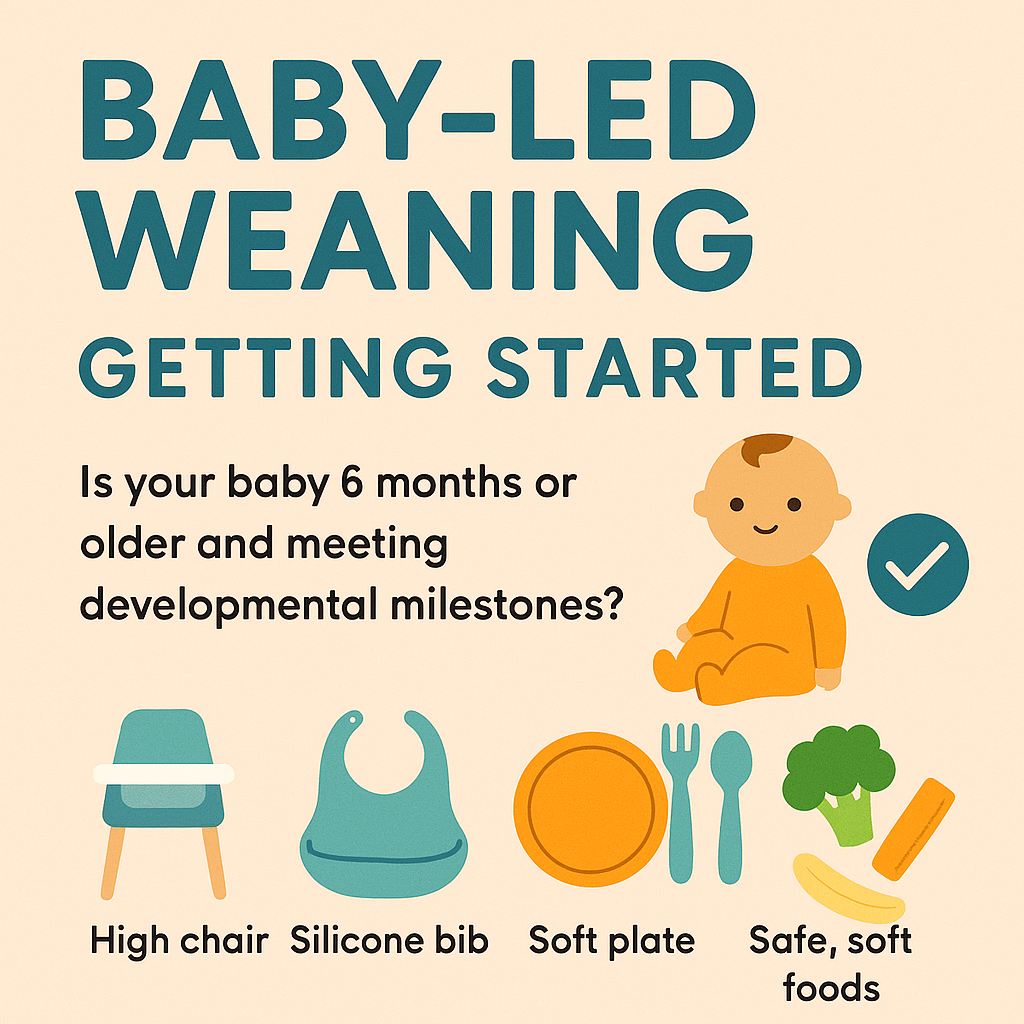
Baby-Led Weaning: Everything You Need to Know to Get Started with Confidence
Partager
Baby-Led Weaning: A New Stage.
Introducing solid foods is a major milestone in your baby’s first year of life. Many parents are exploring an approach that creates independence and intuition: This is where Baby-Led Weaning (BLW) comes into play. BLW is a feeding method that allows infants to take the reins, exploring food at their own pace and developing crucial skills along the way.
In this post, we’ll walk you through the basics of BLW, when and how to start, what tools and gear will make the process smoother, and the many benefits that come with letting your baby take the lead at the dinner table. Make sure to follow us to learn more about parenting and feeding.
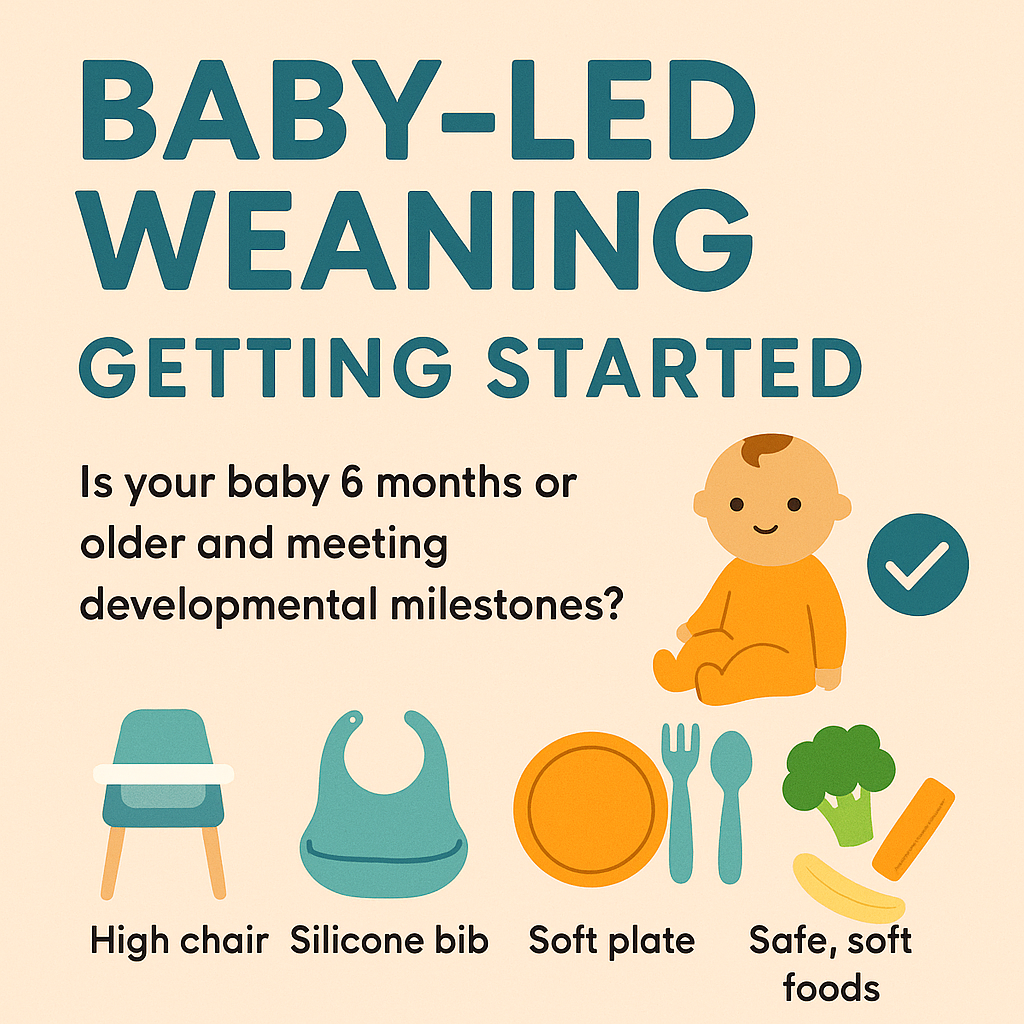
What is Baby-Led Weaning?
Baby-Led Weaning is a method of introducing solid foods that skips purées and spoon-feeding altogether. Instead, you offer your baby soft, finger-sized pieces of food they can grasp and feed themselves.
With BLW, the idea is that your baby gets to explore food on their terms — they pick up the food, bring it to their mouth, and decide how much to eat. This approach fosters a deep connection with hunger and fullness cues, helping babies to self-regulate their intake.
This method has gained popularity in recent years as more parents embrace a less structured, more intuitive approach to feeding.
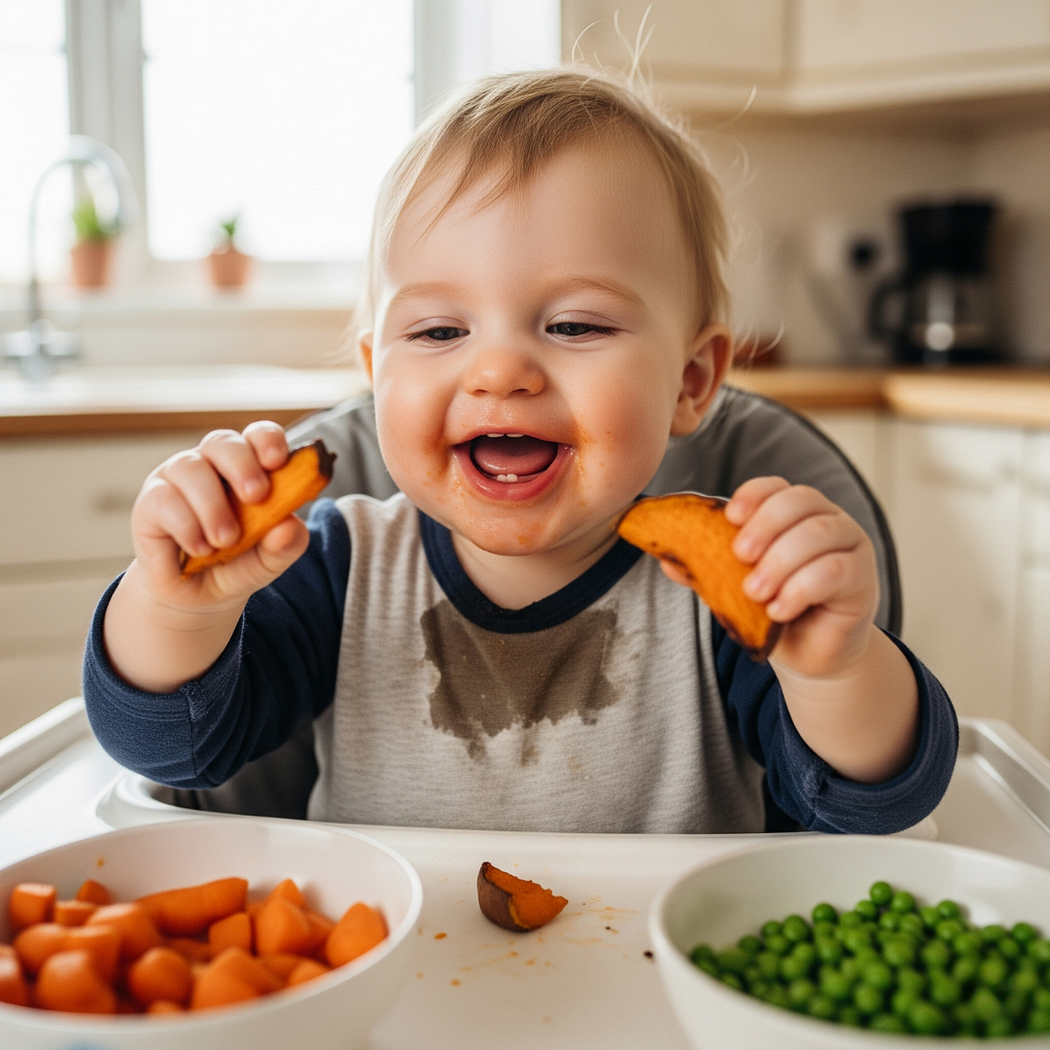
When to Start Baby-Led Weaning?
Timing is crucial for successful and safe baby-led weaning. Experts, including the American Academy of Pediatrics (AAP), recommend starting solid foods around six months of age. This isn’t just an arbitrary number; it aligns with key developmental milestones that indicate a baby is ready for self-feeding.
Look for these signs of readiness:
- Good Head and Neck Control: Your baby should be able to sit up unassisted or with minimal support in a high-chair, holding their head steady. This upright posture is vital for safe swallowing.
- Loss of Tongue-Thrust Reflex: The tongue-thrust reflex is a natural infant reflex that causes babies to push foreign objects out of their mouths. This needs to diminish so they can keep food in their mouths.
- Ability to Grasp and Bring Objects to Their Mouth: Your baby should be able to pick up objects and bring them to their mouth with ease. This hand-eye coordination is fundamental for self-feeding.
- Showing Interest in Food: Is your baby watching you eat with keen interest? Do they reach for food on your plate? These are great indicators that they’re ready to explore.
Starting before these milestones are met can increase the risk of difficulties and frustration for both you and your baby. Patience is key; every baby develops at their own pace.
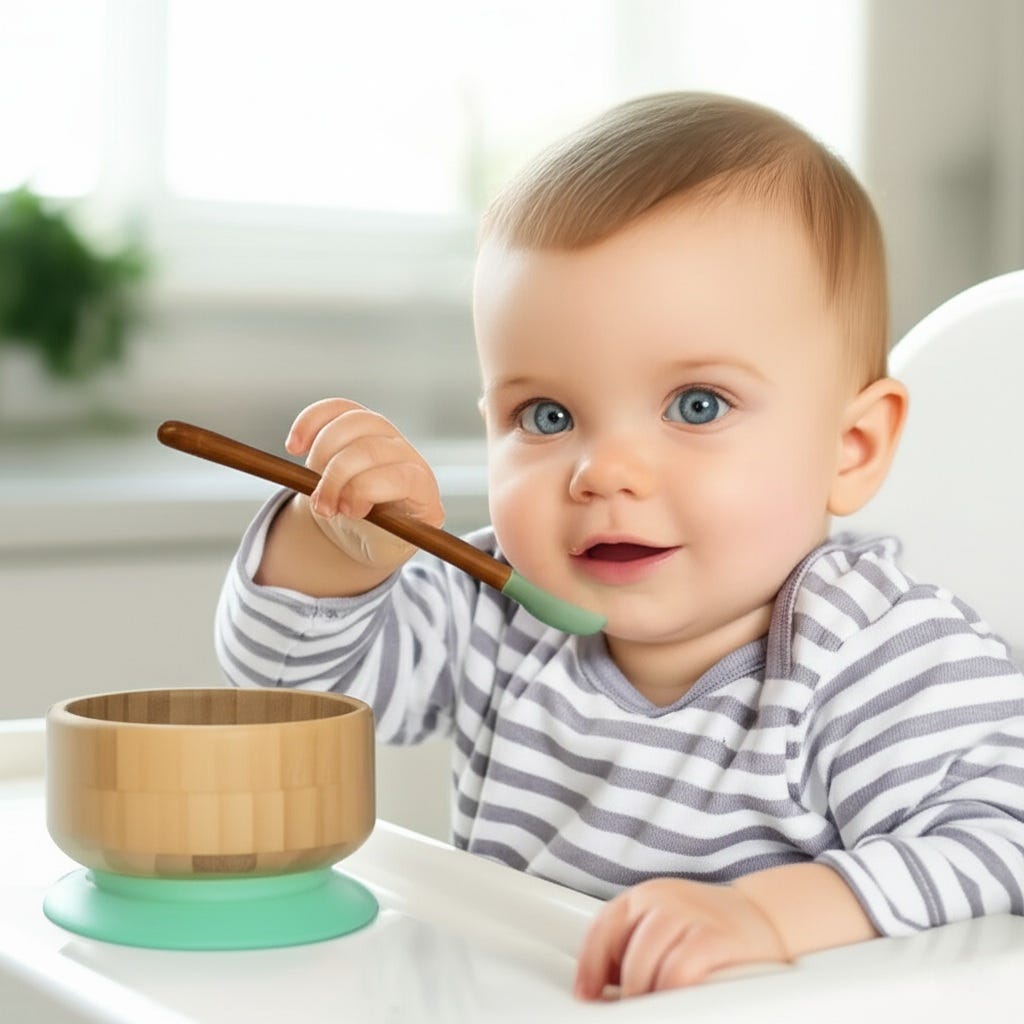
How to Get Started with Baby-Led Weaning: Your First Steps
Once your baby shows all the signs of readiness, getting started with BLW can be exciting! Here’s a basic roadmap:
- Continue Milk Feeds First: Breast milk or formula remains your baby’s primary source of nutrition until at least 12 months. Offer milk before solid food meals so they aren’t ravenous and can focus on exploring.
- Create a Safe Eating Environment: Always ensure your baby is sitting upright in a highchair with good back and foot support. Never leave your baby unattended while eating.
- Start Slowly and Be Patient: Begin with one mealtime a day, or even every few days. The initial goal isn’t about how much food they eat, but about exploration and learning. It’s okay if they don’t eat much at first; milk is still their main nutrition.
- Offer Age-Appropriate Foods:
- Texture is Key: Foods should be soft enough for your baby to mash with their gums against the roof of their mouth. You should be able to squish the food between your thumb and forefinger easily. Steamed vegetables, ripe fruits, and soft-cooked meats are good examples.
- Shape Matters: For babies initially, offer foods in long, thin strips (about the size and shape of your finger) or wedges. This allows them to grasp the food with their whole palm, with a portion sticking out to self-feed. As their pincer grasp develops (around 9 months), you can introduce smaller, bite-sized pieces.
- Prioritize Iron-Rich Foods: Around 6 months, a baby’s iron stores begin to deplete. Offer iron-rich foods at every meal, such as soft, tender pieces of meat or poultry, deboned fish, well-cooked whole eggs, beans, lentils, and iron-fortified cereals (which can be pre-loaded onto a spoon for them).
- Introduce Allergens Safely: Introduce common allergens (like peanuts, eggs, dairy, wheat, soy, fish, and shellfish) one at a time, in very small amounts, and observe for any reactions. Consult your pediatrician for guidance on introducing allergens.
- Eat Together as a Family: Family meals are a cornerstone of BLW. Eating together allows your baby to observe and imitate, making mealtime a positive social experience. Offer your baby modified versions of what the family is eating, ensuring no added salt, sugar, or honey (for babies under one year).
- Anticipate the Mess: BLW is messy, and that’s perfectly normal! Embrace the chaos as part of the learning process. A little mess means a lot of exploration.
- Offer Water: Introduce a small amount of water (4–8 ounces per day) in an open cup or straw cup when you start solids.
Getting Started: The Essentials
Before you jump into BLW, you’ll need a few simple tools to make the process cleaner, safer, and more enjoyable — for both you and baby.
1. High Chair with Proper Support
A sturdy high chair with a footrest and upright back support is key. Good posture helps babies manage chewing and swallowing safely.
2. Silicone Bibs
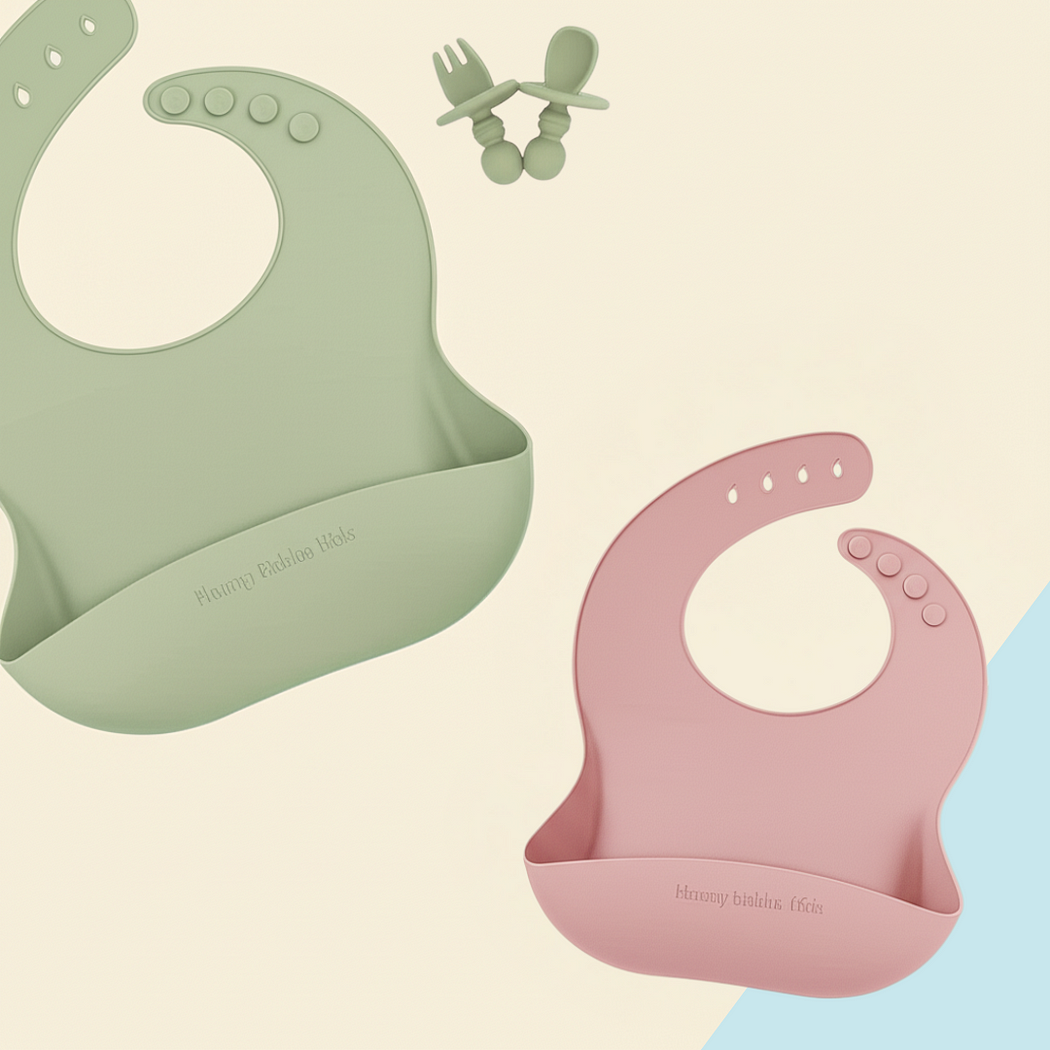
Invest in a few silicone bibs with food-catching pockets. They’ll save you from a mountain of laundry and keep your baby relatively clean during messy meals.
3. Easy-Grip Utensils and Cups
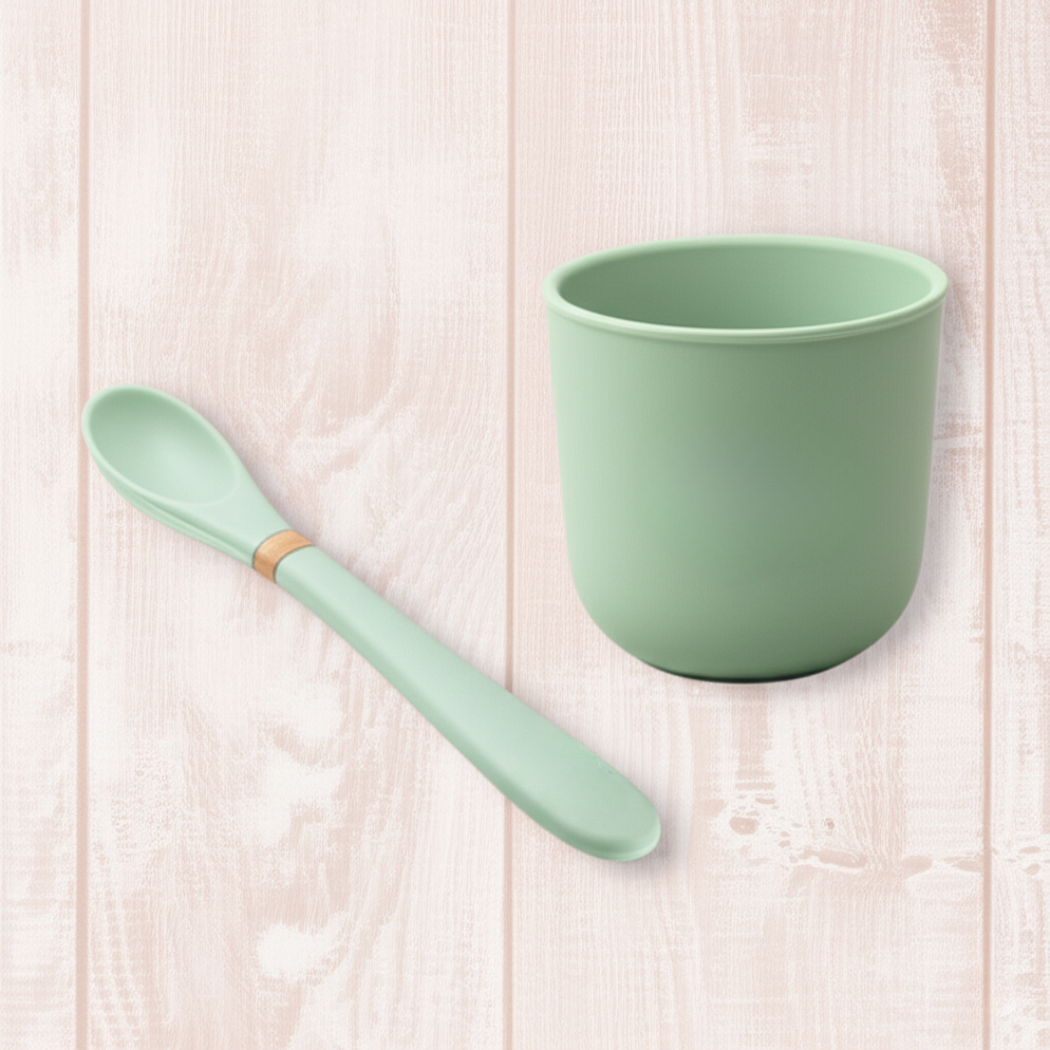
While babies primarily use their hands, offering soft silicone spoons and small, open cups or straw cups encourages utensil familiarity and promotes oral motor development. Look for spoons designed for little hands to grip easily
4. Non-Slip Plates or Suction Bowls
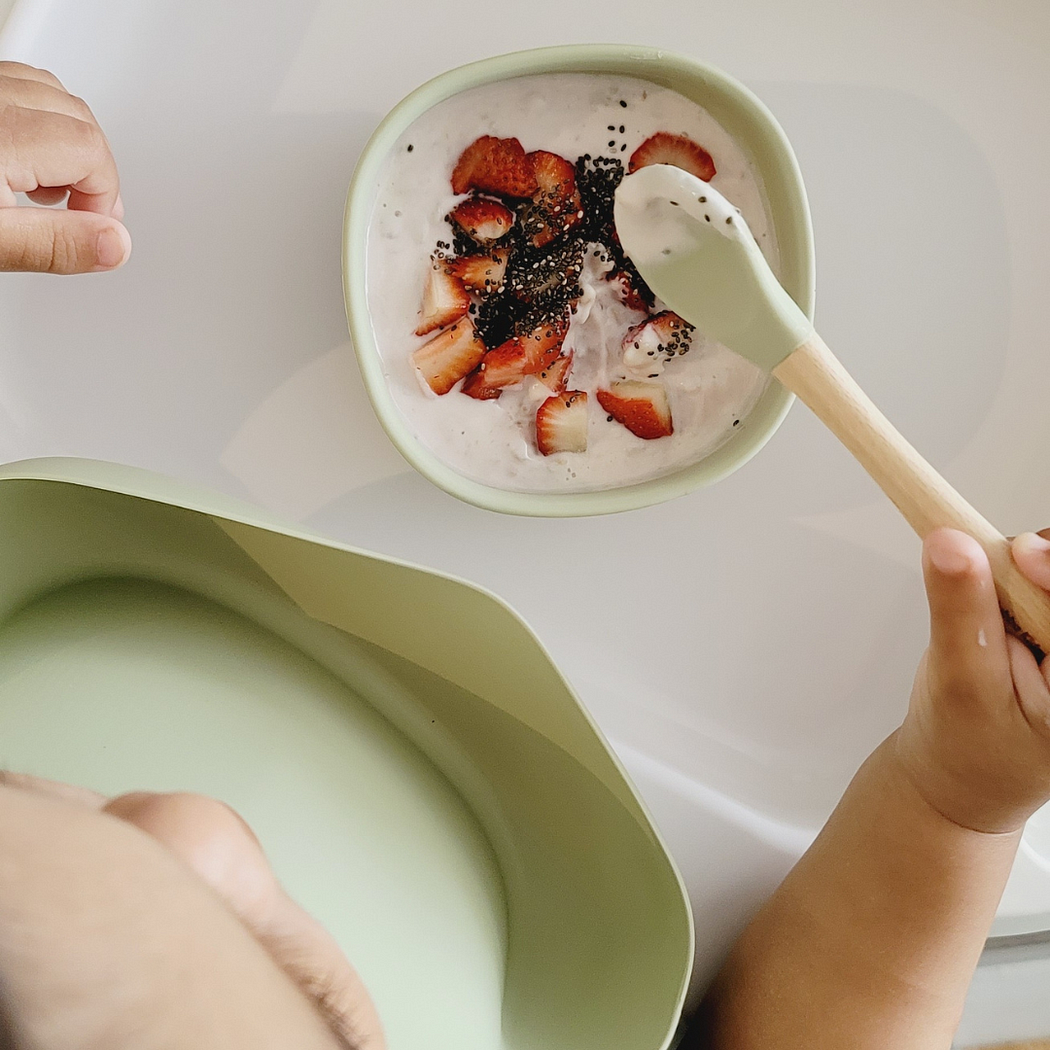
This helps keep food in place while the baby explores. Look for BPA-free, dishwasher-safe options.
5. Mess-Friendly Environment
A splash mat under the highchair or feeding in an easy-to-clean area can save your floors (and your sanity).
6. Floor Mat:
A wipe-clean mat under the high chair can save your floors from food splatters.
7. An All-In-One BLW Tableware Set:
This complete BLW tableware set is designed to help your baby through the Baby-Led Weaning Stage. It comes with all the items you will need in one set, saving you money and time.
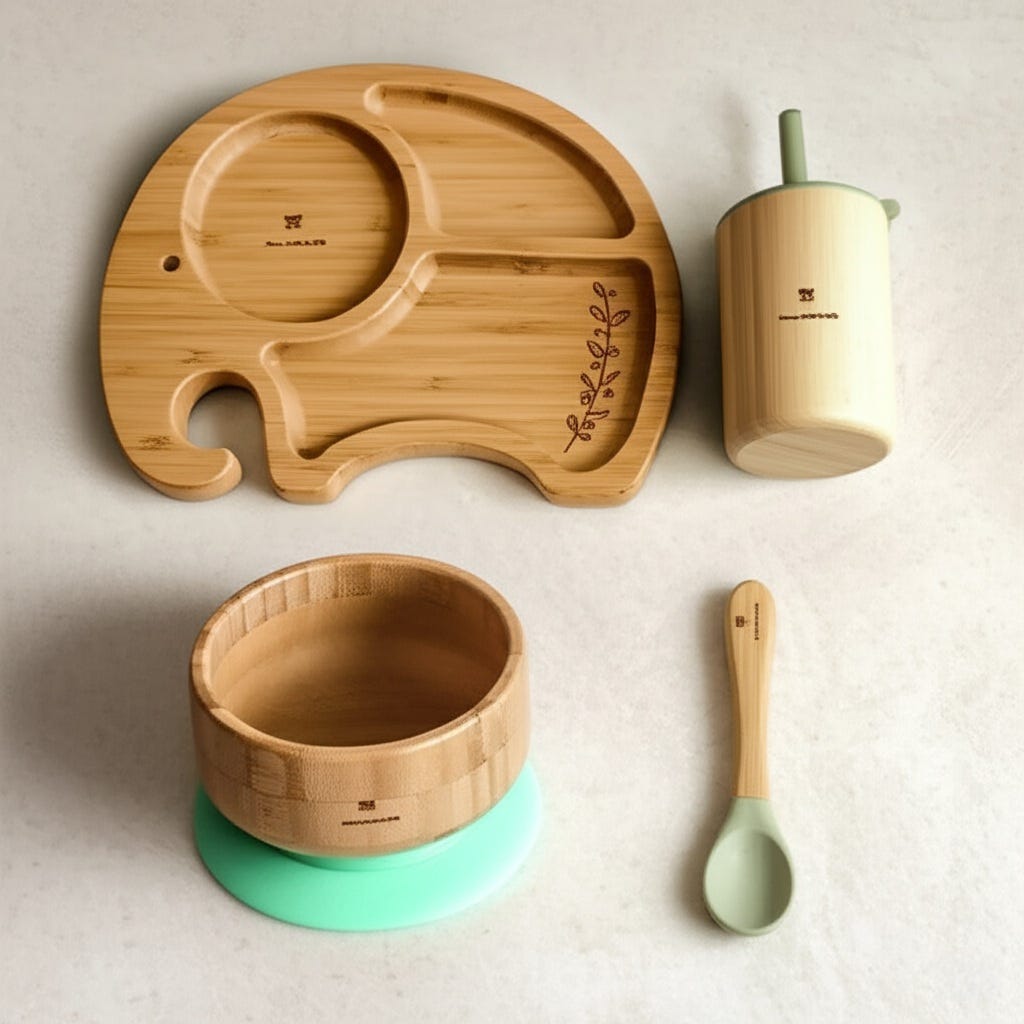
What Foods to Offer First
Start with soft, whole foods that are easy to grasp and gum. Good beginner foods include:
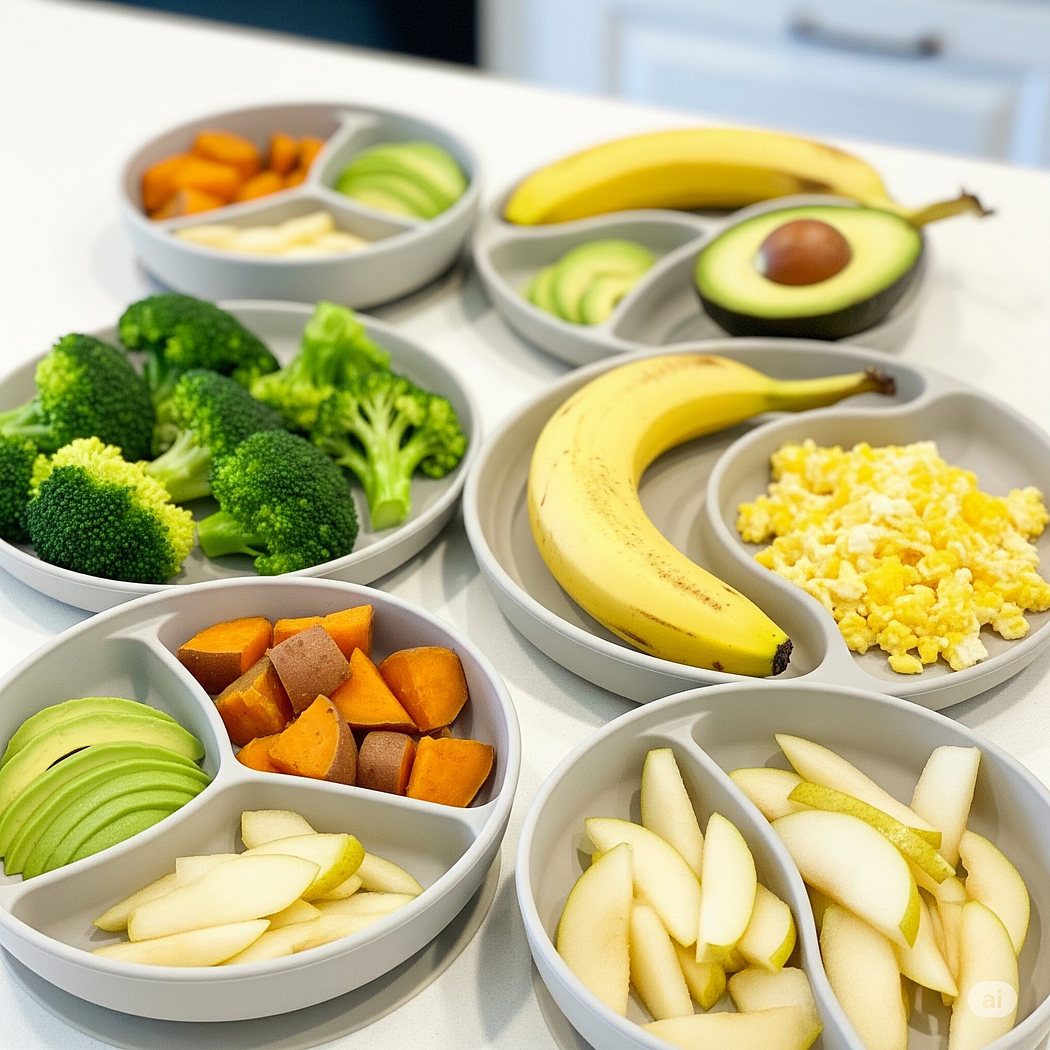
- Steamed broccoli florets
- Ripe banana (cut in half lengthwise)
- Slices of avocado
- Soft-cooked sweet potato wedges
- Scrambled eggs
- Strips of ripe pear or apple (steamed if needed)
Avoid choking hazards such as whole grapes, raw carrots, popcorn, nuts, or anything that’s small and hard.
It’s also important to introduce one new food at a time, waiting a couple of days before adding another. This makes it easier to identify potential allergens.
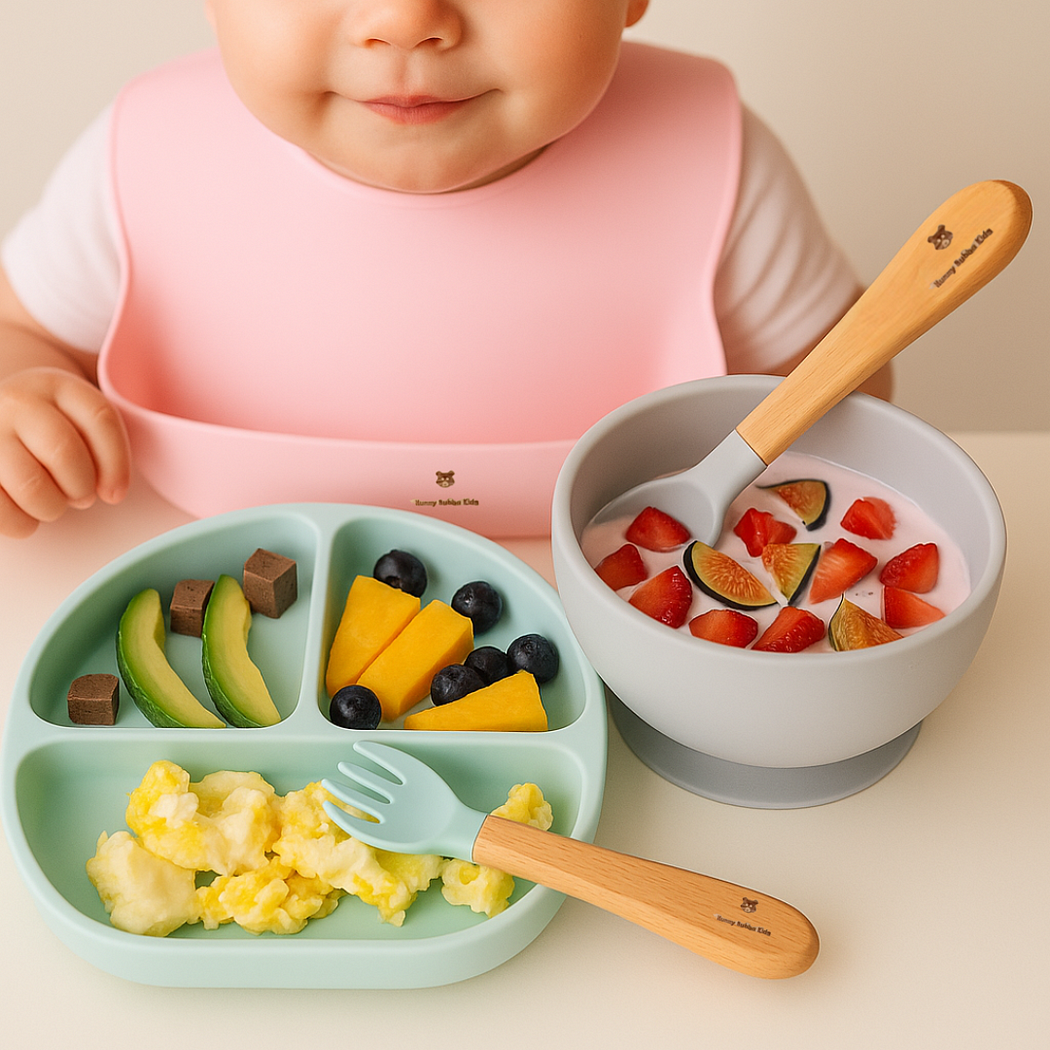
Benefits of Baby-Led Weaning
The advantages of embracing BLW extend far beyond just mealtime:
- Fosters Independence and Self-Regulation: By allowing babies to control what and how much they eat, BLW teaches them to listen to their internal hunger and fullness cues. This self-regulation can potentially reduce the risk of childhood obesity later in life.
- Develops Oral and Fine Motor Skills: Grasping, bringing food to the mouth, biting, chewing, and swallowing a variety of textures all contribute to the development of fine motor skills, hand-eye coordination, and crucial oral motor skills necessary for speech development.
- Encourages a Diverse Palate: Exposure to a wide range of flavors and textures from an early age can lead to less picky eating habits and a greater acceptance of different foods as they grow.
- Convenience for Parents: You can often offer your baby modified versions of family meals, reducing the need for separate meal preparations and making dining out simpler.
- Promotes Family Mealtime Integration: BLW naturally brings babies to the family table, fostering social interaction and a sense of belonging during mealtimes. This can contribute to positive long-term eating habits and family bonds.
May Reduce Picky Eating: By allowing babies to explore and have control over their food, they may be less likely to develop power struggles around food and become picky eaters.
Final Thoughts: Is BLW Right for You?
Every baby is different, and so is every parent. Baby-Led Weaning isn’t a one-size-fits-all solution — but for many families, it offers a fun, healthy, and empowering way to introduce solids.
Whether you go full BLW or take a hybrid approach (mixing finger foods with some spoon-feeding), the goal is the same: to help your baby develop a positive relationship with food.
The most important thing? Follow your baby’s lead, stay patient, and enjoy the messy, magical ride.
Ready to Start?
Here’s a quick checklist to help you prepare:
- ✅ Baby is around 6 months old and meets developmental milestones
- ✅ High chair with foot support
- ✅ Silicone bibs, soft plates, and baby-safe utensils
- ✅ Safe, soft foods cut into finger-size shapes
- ✅ Patience, humor, and lots of baby wipes!
Sources & Further Reading:
- Hunny Bubba Kids: Baby-Led Weaning vs. Traditional Spoon Feeding
- NHS UK: Your Baby’s First Solid Foods
- American Academy of Pediatrics (AAP) Guidelines
- Nutrition For Healthy Term Infants: Recommendations from six to 24 months.
- Rapley, Gill & Murkett, Tracey. Baby-Led Weaning: Helping Your Baby to Love Good Food
